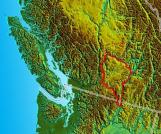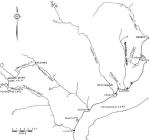1
Geologic History of the Interior Plateau and the Okanagan115 to 85 million years ago
Peachland Watershed
 Credits:
Credits:Robert Merrill, Peachland, 2008
M. A. Roed, and J. D. Greenough (eds). Okanagan Geology, British Columbia. Kelowna Geology Committee, Kelowna
2
The geologic history of the Okanagan Valley began about 700 million years ago when the North American Plate separated from a much larger 2 billion year old continent and began drifting north westward, sliding over the heavier Pacific Plate. It was then located on the equator. Sediments containing fossilized skeletons of the first shell fish began to be deposited on the Pacific Plate west of the North American Plate about 550 million years ago.About 115 million years ago, the North American Plate encountered the Pacific Plate. The heavier lower layers were forced under the west coast and the lighter sedimentary and lava layers rode over it and were folded and fractured, creating the Rocky Mountains. A second collision occurred about 85 million years ago creating the front ranges, foothills and the north-south trending Okanagan & San Andreas faults. At some time during this last period the land on the west side of the Okanagan Fault subsided several hundreds of meters.
The world entered the Ice Age 1.8 million years ago when global temperatures fell and rose at least four times creating glacial periods and intervening interglacial periods. The last continental sheet receded from British Columbia 12000 years ago. During each of these periods the ice sheet had covered all but the highest peaks. The four periods of advancing glaciers deepened the Okanagan Valley to below sea level removing most of the folded rocks on the east side to expose the 2 billion year old Okanagan Mountain Park across from Peachland. The previous subsidence on the west side of the fault has resulted in the oldest rocks on the west side being only 300 million years old or younger, covering the ancient rocks hundreds of meters below.
During each of the interglacial periods, rivers flowing from the melting ice dropped silt, sand and boulders in the valley. When the last period ended melting ice created glacial Lake Penticton and floating ice blocked the valley near Oliver. The water backed up to the top the cliffs there. When the dam finally broke the rushing outflow dropped the lake level and scoured the bottom, leaving silt cliffs along the west side above Penticton to show where the bottom had been. Lake Okanagan remained to be later dammed up at O.K. Falls
4
What makes the climate of the Okanagan Valley?Lying in the rain shadow of the Coast and Cascade mountains, the Okanagan Valley has a dry climate. Precipitation increases from south to north in the valley, with an everage of 11 inches of rain and 3 feet of snow falling each year in Peachland. The temperature during July and August averages around 30.4 C and during December and January the average is -5.7 C.
Climate change is taking place in the Okanagan Valley. The climate became warmer and wetter in the last century; an average of 27 more frost-free days occurred in 1993 than were recorded in 1907. With more frost-free days, the growing season is longer and requires more irrigation water. More precipitation also falls as rain rather than snow, so the timing changes of water inputs to streams.
Streams in the Okanagan are fed mainly by the snow melting in spring that enters the streams. This high water flow, called the spring freshet contributes two-thirds of the annual stream flow. By July, the freshet period ends and the water flow remains low for the summer, autumn, and winter. This means that water flow in creeks is low during the peak irrigation months and during the peak migration and spawning periods for fish.
Scientists have noticed changes in streams that are probably related to climate change: an earlier start to the spring freshet, lower water flow in autumn, and higher water flow in early winter. They predict that these trends will continue over the next 80 years.
